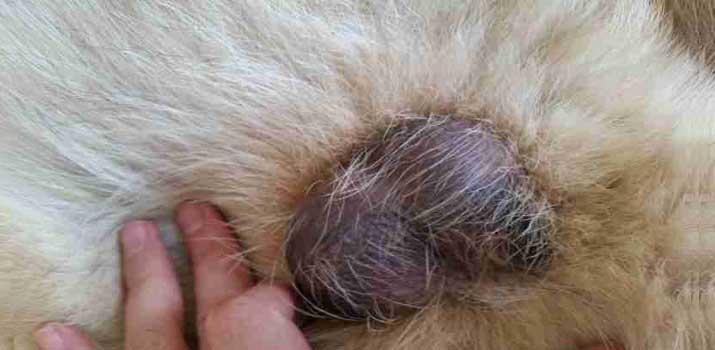
A big part of being a responsible and proactive dog owner is checking your furry friend for anything unusual with their physical body.
Your dog can’t outright tell you that they’re in pain or suffering from a medical condition. So, you have to take matters into your own hands and pay close attention to their body.
Dog owners won’t hesitate to check the fur, eyes, and ears in most cases. But what about your male dog’s “unmentionables? That’s right: We’re talking about balls here!
Some people like to ignore this part of their dog’s anatomy, but it’s a crucial body part that says a lot about your companion’s health. The balls are the scrotal sac that contains the testes.
Keeping an eye on the testicles is crucial and should be a part of the normal grooming process.
Once you get over the initial discomfort, you’ll learn what’s normal for your dog in terms of shape, color, and form. So what if something abnormal catches your eye?
One of the most alarming changes dog owners can observe is the testicles turning dark or black.
So what does it mean?
What Healthy Balls Look Like

Before we get into blackened balls, let’s talk about what’s normal. All dogs are different, so expect some slight variations.
Most dogs have testicles that are gray-colored. Depending on your pup’s skin color, the hue might lean more towards pink or brown.
Like any other part of the body, the skin color on the balls will vary based on their pigmentation. Some dogs also have fur that could make the color appear a certain way.
Of course, dogs with black skin will likely already have black balls. But even then, the color could deepen more, which could be a cause for concern.
Male puppies won’t appear to have any balls at all when they’re super young. They won’t “drop” until two to six months of age.
Whenever they first appear, take notice of them! You can only spot differences in appearance by having a baseline to compare.
5 Reasons Why Your Dog’s Balls are Black
When the skin color on your dog’s ball changes, they’re experiencing an issue known as hyperpigmentation.
Hyperpigmentation can happen anywhere on the body, and it’s not an automatic cause for concern.
What matters most is the accompanying symptoms and timing of the color change. More on that later.
For now, here are some base-level causes to think about should you see your dog’s balls turn black.
1 – Recent Injury
In some cases, discoloration is a product of bruising. It’s the same type of issue you would see if your dog got hurt on any other part of the body.
The blood pools under the skin because of busted capillaries, creating a darkness that can worsen over time.
Injuries to this region are excruciating, so you might be able to link the discoloration to a specific event. But if you weren’t there to witness the injury, the bruising can be alarming.
Examine the scrotum further and look for scrapes, other bruises, or cuts.
Be very gentle here! Bruising makes the balls even more tender and sensitive than they were earlier. Continue monitoring the balls and your dog’s behavior.
If your pup is doing fine, there’s no immediate reason to worry. However, you should take your dog to the vet if they seem seriously affected by the injury.
Significant behavioral changes are not something you should ignore.
The same goes for continued discoloration.
In rare cases, the injury can be so severe that it affects blood circulation to that area. When that happens, the skin essentially dies and turns into a dramatic shade of black.
If that occurs, take your dog to the vet as soon as possible.
2. – Skin-Related Problems
Hyperpigmentation can also happen because of skin issues. Look closely, and you might also see some peeling.
Don’t panic! Darkening and peeling can happen because of a lack of moisture.
Think of it as the grayish color that develops on human knees and elbows when they get dry. It’s just a lack of hydration!
Your dog might lick their balls more frequently. If that’s the case, apply some hydrating vaseline or natural coconut oil.
You don’t want your dog to lick their scrotum excessively. Otherwise, it can lead to more severe skin problems.
Related read: How to Get Your Dog to Drink More Water
3 – Disease or Infection
Infections and disease could be to blame as well. Infections are pretty common and can cause darkening in rare cases.
The discoloration could also be a sign of cancer. Hyperpigmentation is just one of many cancer symptoms. It also causes hair loss, swelling, asymmetry, and changes in urination habits.
If you even remotely suspect testicular cancer is to blame, we recommend taking a trip to the vet.
Cancer can wreak havoc on your dog’s body. The earlier you catch it, the better!
The most common treatment for testicular cancer in dogs is surgery, but you must act early to ensure that your dog has the best chances possible.
4- Old Age
Believe it or not, mature age is the most common reason for hyperpigmentation on the balls.
As your furry friend gets older, the levels of skin pigmentation, called melanin, increase. It tends to accumulate in small deposits.
That’s why you might see black spots forming as your dog approaches seniorhood. Those spots aren’t a big deal, nor is large-scale hyperpigmentation in senior dogs.
Typically, this discoloration occurs slowly over time. It only appears sudden because most people often ignore the color of their dog’s balls. That’s especially true if your dog stops rolling on his back as he ages.
When you finally see them, the darker color seems to come out of nowhere.
But fear not, this darkening isn’t an issue.
What About Neutered Dogs?
Obviously, a neutered dog isn’t going to have any balls for you to monitor! The neutering process removes them entirely. However, the area can still darken.
The immediate recovery period after neutering may cause swelling and discoloration. However, it should go away within a few days.
Make sure to follow your vet’s recommendations and have them wear an Elizabethan cone to prevent licking and the risk of infection. If the coloring doesn’t subside, don’t be afraid to ask your vet for guidance.
If the scrotal area darkens later in life, many of the same issues a non-neutered dog experiences will apply.
Hyperpigmentation from old age, skin infections, and injuries can occur, so make sure to monitor the area even if your pooch doesn’t have balls!
Related: Walking Your Dog for the First Time After Neutering
When to Be Worried
As you can see, there are both benign and potentially serious causes for your dog’s balls to turn black. So, when should you raise the alarms?
As we mentioned earlier, it’s all about monitoring your dog and paying attention to any other accompanying symptoms.
Compulsive Licking
If your dog doesn’t stop licking their balls, there could be a severe issue underfoot. Look closely and see if the skin is dry. In that case, a bit of hydrating cream or oil could fix the problem.
But if that doesn’t stop the licking, go to the vet! Your dog could be dealing with a skin infection or an internal injury.
Always visit a vet to rule those out. It’s better to be safe than sorry.
Related: How to Stop Your Dog from Licking Other Dogs Urine
Swelling
Swelling is another thing that should raise red flags. Swelling is a common symptom of Epididymitis and Orchitis.
Epididymitis is when the testicular tube inside your dog’s groin that stores sperm swells up.
Orchitis refers to the general swelling of the testes themselves.
Either way, both can be painful and linked to underlying medical concerns. Your dog will likely lick the balls to find relief, so keep an eye out for swelling.
Redness
Black is a pretty concerning color, but seeing red isn’t any better!
If you see general redness or several pink spots, it could indicate a superficial infection. Redness is usually a sign of inflammation, so nothing good can come from it.
The color could be a product of physical injury, too. For example, testicular torsion happens when the spermatic cord prevents blood flow.
The balls usually turn bright red before going black. Once again, a trip to your vet is a must!
Extreme Behavioral Changes
Finally, monitor your dog’s behavior. You might notice them walking funny, whelping in pain when they make specific movements, or having difficulty urinating.
Some dogs will get super sensitive and angry, too. They might lash out if you or anyone else tries to touch them.
You know your dog better than anyone else. If they start acting out of the ordinary and have changes to the appearance of the balls, get professional veterinary help.
Conclusion
No one wants to look at their dog’s balls, but doing so could help you stay updated on their health.
Black balls aren’t always a significant health concern, but you never know what’s happening with your dog’s body until you pay attention.
Keep an eye on their behavior and don’t ignore any sudden changes. When in doubt, contact your vet to rule out medical concerns. That peace of mind makes all the difference.
Also read: How Often You Should Worm Your Puppy

